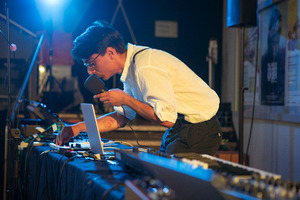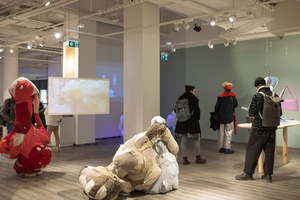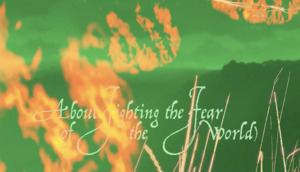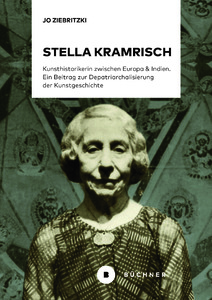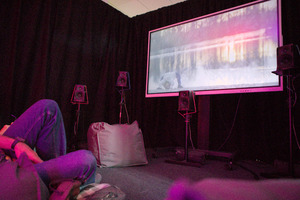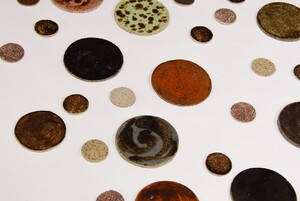Sets
330 Inhalte
- Seite 1 von 28
20-rOundabOut-24
- Titel
- 20-rOundabOut-24
- Beschreibung (de)
- Rundgangskonzert von Studierenden, Alumni und Freunden der HfG Karlsruhe mit Live-Elektronik, Fixed Media, Audiovisuellen Projektionen und Live Performances
- Kategorie
- Titel
- 20-rOundabOut-24
- Importiert am
- 15.01.2025
- Übergeordnete Sets
- 1
- Set enthält
- 0 12
25 GRAD: Diplomausstellung 2025
- Titel
- 25 GRAD: Diplomausstellung 2025
- Beschreibung (de)
- Vom 13. bis 23. Februar 2025 wird die Karlsruher Innenstadt zur Bühne für die Graduiertenausstellung „25 Grad“ der Hochschule für Gestaltung Karlsruhe. Rund 30 Absolvent:innen präsentieren ihre Abschlussarbeiten und machen ihre Werke einer breiten Öffentlichkeit zugänglich. Der Titel „25 Grad“ symbolisiert den Zeitpunkt des Übergangs vom Hochschulabschluss in die Professionalität.
Eröffnet wird die Ausstellung am 13. Februar um 17 Uhr im Erdgeschoss der Postgalerie Karlsruhe mit einer Vernissage, die Begegnungen zwischen den Absolvent:innen und dem Publikum anregt und den Startpunkt für ein vielseitiges Programm bildet. Insgesamt wird es zwei Ausstellungsorte geben: neben zweier ehemaliger Ladenflächen im EG der Postgalerie Karlsruhe, wird auch der Badische Kunstverein in der Waldstraße 3, im Karlsruher Zentrum zum Ausstellungsraum. Die Ausstellungsorte werden durch einen gemeinsamen Spaziergang am selben Abend des 13.2.25 aktiviert. Ein vielfältiges Programm aus Screenings, Kolloquien und Workshops während der gesamten Ausstellungslaufzeit, lädt dazu ein, mit den Künstler:innen und Designer:innen in den Austausch zu treten. Den Abschluss markiert die Finissage am 23. Februar.
Die Ausstellung zeigt erneut die interdisziplinäre Qualität, die das Studium an der HfG Karlsruhe prägt. Die gezeigten Arbeiten reflektieren die enge Zusammenarbeit zwischen und in unterschiedlichen Fachrichtungen und verdeutlichen, wie stark die Studierenden nicht nur von den Lehrenden, sondern auch voneinander lernen und sich gegenseitig inspirieren. Diese Einflüsse, die fachliche Grenzen überschreiten, ,werden in einem begleitenden Magazin vorgestellt, das einen tiefen Einblick in die Arbeitsweisen und -prozesse der Ausstellenden gibt.
Weitere Informationen zu den Standorten, Ausstellenden und Programmpunkten folgen hier sowie auf der Instagram-Seite der Graduiertenshow unter @grad.hfg.
Opening, 13.02.2025 um 17 Uhr: Postgalerie Karlsruhe / Kaiserstraße 217 / 76133 Karlsruhe
Weiterer Ausstellungsort:
Badischer Kunstverein e.V. / Waldstr. 3. / 76133 Karlsruhe
- Vom 13. bis 23. Februar 2025 wird die Karlsruher Innenstadt zur Bühne für die Graduiertenausstellung „25 Grad“ der Hochschule für Gestaltung Karlsruhe. Rund 30 Absolvent:innen präsentieren ihre Abschlussarbeiten und machen ihre Werke einer breiten Öffentlichkeit zugänglich. Der Titel „25 Grad“ symbolisiert den Zeitpunkt des Übergangs vom Hochschulabschluss in die Professionalität.
- Beschreibung (en)
- From 13 to 23 February 2025, Karlsruhe city centre will become the stage for the ‘25 Grad’ graduate exhibition at the Karlsruhe University of Arts and Design. Around 30 graduates will present their final theses and make their work accessible to the general public. The title ‘25 degrees’ symbolises the time of transition from graduation to professionalism.
The exhibition will open on 13 February at 5 p.m. on the ground floor of the Postgalerie Karlsruhe with a vernissage that will encourage encounters between the graduates and the public and form the starting point for a varied programme. In addition to a former shop space in the Postgalerie Karlsruhe, the exhibition space of the Badischer Kunstverein at Waldstraße 3 in the centre of Karlsruhe will also be used. The exhibition venues will be activated by a joint walk on the same evening of February 13, 2025. A varied programme of screenings, colloquia and workshops throughout the duration of the exhibition invites visitors to enter into an exchange with the artists and designers. The finissage on 23 February marks the end of the exhibition.
The exhibition once again demonstrates the interdisciplinary quality that characterises studies at the HfG Karlsruhe. The works on display reflect the close co-operation between and within different disciplines and illustrate the extent to which students not only learn from their teachers, but also from each other and inspire each other. These influences, which transcend disciplinary boundaries, are presented in an accompanying magazine that provides an in-depth insight into the exhibitors' working methods and processes.
Further information on the locations, exhibitors and programme items will follow here and on the Graduate Show's Instagram page at @grad.hfg.
Opening, February 13, 2025 at 5pm at Postgalerie Karlsruhe / Kaiserstraße 217 / 76133 Karlsruhe
Further location: Badischer Kunstverein e.V. / Waldstr. 3. / 76133 Karlsruhe
- From 13 to 23 February 2025, Karlsruhe city centre will become the stage for the ‘25 Grad’ graduate exhibition at the Karlsruhe University of Arts and Design. Around 30 graduates will present their final theses and make their work accessible to the general public. The title ‘25 degrees’ symbolises the time of transition from graduation to professionalism.
- Kategorie
- Datierung
- 13.02.2025 - 23.02.2025
- Ort: Institution
- Beteiligte Institution(en)
- Titel
- 25 GRAD: Diplomausstellung 2025
- Importiert am
- 16.09.2024
- Übergeordnete Sets
- 1
- Set enthält
- 30 0
25 Grad: Graduierte im Gespräch
- Titel
- 25 Grad: Graduierte im Gespräch
- Beschreibung (de)
- In den zwei Kolloquien tauschen sich Absolvent:innen aus den verschiedenen Disziplinen der HfG über ihre Abschlussarbeiten aus. In offener Runde geben sie einen Einblick in die Entstehung und Entwicklung ihrer Projekte. Das Publikum ist eingeladen, Fragen zu stellen und mit zu diskutieren.
15.02.2025: Julius Bläser, Eike Buff, Lara Landbrecht, Janosch Kratz
22.02.2025: Florian Knöbl, Mona Mayer, Bob Reinert
- In den zwei Kolloquien tauschen sich Absolvent:innen aus den verschiedenen Disziplinen der HfG über ihre Abschlussarbeiten aus. In offener Runde geben sie einen Einblick in die Entstehung und Entwicklung ihrer Projekte. Das Publikum ist eingeladen, Fragen zu stellen und mit zu diskutieren.
- Beschreibung (en)
- In the colloquia, graduates from the various disciplines at the HfG discuss their final projects. In open discussions, they provide an insight into the creation and development of their projects. The audience is invited to ask questions and join in the discussion.
15.02.2025: Julius Bläser, Eike Buff, Lara Landbrecht, Janosch Kratz
22.02.2025: Florian Knöbl, Mona Mayer, Bob Reinert
- In the colloquia, graduates from the various disciplines at the HfG discuss their final projects. In open discussions, they provide an insight into the creation and development of their projects. The audience is invited to ask questions and join in the discussion.
- Typ des Projekts/Werks
- Datierung
- 15.02.2025 und 22.02.2025
- Mitwirkende
- Ort: Institution
- Titel
- 25 Grad: Graduierte im Gespräch
- Importiert am
- 04.03.2025
- Übergeordnete Sets
- 1
- Set enthält
- 0 0
25 Grad: Vernissage
- Titel
- 25 Grad: Vernissage
- Titel (en)
- 25 Grad: Opening
- Kategorie
- Datierung
- 13.02.2025
- Ort
- Postgalerie Karlsruhe / Kaiserstraße 217 / 76133 Karlsruhe
- Postgalerie Karlsruhe / Kaiserstraße 217 / 76133 Karlsruhe
- Titel
- 25 Grad: Vernissage
- Importiert am
- 24.02.2025
- Übergeordnete Sets
- 1
- Set enthält
- 0 13
7QM
- Titel
- 7QM
- Titel (en)
- 7sqm - inside views
- Untertitel
- Innen(an)sichten
- Autor/in
- Beschreibung (de)
- Was passiert, wenn Individuen in engen, geschlossenen Räumen mit kaum persönlicher, sondern standardisierter, fest verankerter, textilloser Ausstattung leben, in denen sie einer permanenten Überwachung und Kontrolle sowie streng geregelten Tagesabläufen ausgesetzt sind?
Mascha Dilger untersucht die Parameter sanktionierender Räume: Besuche in unterschiedlichen Justizvollzugsanstalten und Interviews mit ehemaligen Inhaftierten werden in der Rauminstallation 7qm - Innen(an)sichten verarbeitet. Realitäten eines vor der Gesellschaft verborgenen und von ihr verdrängten Ortes werden offengelegt.
Die Arbeit beleuchtet, wie aus einem fremdbestimmten, rasterartigen Alltag einer totalen Institution, Versuche der geistigen Flucht und der Selbstbestimmtheit hervorgehen können. Es werden ortsspezifische und subkulturelle Erscheinungsformen betrachtet, die als Überlebensstrategien zu verstehen sind.
- Was passiert, wenn Individuen in engen, geschlossenen Räumen mit kaum persönlicher, sondern standardisierter, fest verankerter, textilloser Ausstattung leben, in denen sie einer permanenten Überwachung und Kontrolle sowie streng geregelten Tagesabläufen ausgesetzt sind?
- Beschreibung (en)
- What happens when individuals live in narrow, confined spaces with hardly any personal but standardized, firmly anchored, textile-less furnishings, in which they are exposed to permanent surveillance and control as well as strictly regulated daily routines?
Mascha Dilger investigates the parameters of sanctioning spaces: visits to various prisons and interviews with former inmates are processed in the spatial installation "7qm - Innen(an)sichten". Realities of a place hidden from society are revealed.
The work illuminates how attempts of mental escape and self-determination can emerge from the grid-like everyday life of a total institution. Site-specific and subcultural manifestations are considered, which are to be understood as survival strategies.
- What happens when individuals live in narrow, confined spaces with hardly any personal but standardized, firmly anchored, textile-less furnishings, in which they are exposed to permanent surveillance and control as well as strictly regulated daily routines?
- Kategorie
- Typ des Projekts/Werks
- Schlagworte
- Datierung
- 11.07.2023 - 12.07.2023
- Mitwirkende
- Dank an
- Zaur Ahlimanov
- Phillip Banian
- Jeremias Beckford
- Sandra Blatterer
- Barbara Bohnen
- Matthias Bruhn
- Richard Brunner
- Céline Condorelli
- Hannah Cooke
- Jaya Demmer
- Lina Determann
- Alfred Dilger
- Nicola Dilger
- Susanne Dilger
- Manfred Döpke
- Nina Eberle
- Kerstin Eisenmenger
- Constanze Fischbeck
- Ebba Fransén Waldhör
- Laura Haak
- Uwe Habel
- Laurine Haller
- Igor Hardt
- Lina Höhne
- Lovis Iglinski
- Martina Kaltenbrunner
- Tobias Keilbach
- Alexander Knoppik
- Katja Koch
- Mikail Kolbasar
- Hanne König
- Susanne Kriemann
- Claudia Kröhl
- Barbara Kuon
- Alexia Metge
- Paulina Mimberg
- Ilja Morgenstern
- Leonie Mühlen
- Minh Anh Nguyen
- Luise Peschko
- Vlado Petrovic
- Milena Petrovic
- Tibor Pilz
- Christian Platz
- Paul Platz
- Waldemar Präg
- Corinne Riepert
- Thomas Rustemeyer
- Sebastian Schäfer
- Max Schäffer
- Philipp Schell
- Susanne Schmitt
- Mischa Schneider
- Waldemar Schwab
- Henriette Schwabe (Jette Schwabe)
- Manuel Sékou
- Alexander Theis
- Alexander Thelen
- Lisa Tölle
- Jan Tölle
- Lioudmila Voropai
- Badaue
- Initiative „Faites Votre Jeu!“
- AStA
- JVA Bühl
- Exit - Enter Life e.V.
- JVA Mannheim
- Sprache
- Material
- Ort: Institution
- Ort
- im großen Studio
- Stadt
- Land
- Beteiligte Institution(en)
- Titel
- 7QM
- Projektleiter/in
- Semester
- Studiengang
- Typ der Abschlussarbeit
- Importiert am
- 26.07.2023
- Übergeordnete Sets
- 3
- Set enthält
- 4 2
About Fighting the Fear (of the World)
- Titel
- About Fighting the Fear (of the World)
- Titel (en)
- About Fighting the Fear (of the World)
- Autor/in
- Beschreibung (de)
- "Über das Bekämpfen der Angst (vor der Welt)" ist eine spekulative Videoarbeit, die ein Spektrum von Phänomenen rund um Karten, Angst, Krieg, Reisen und den Körper abdeckt, wobei der Schwerpunkt auf der Praxis der Kartierung als Instrument zur Unterdrückung und Kontrolle von Land und Menschen liegt. Das Video versucht, einen Rahmen für das Thema zu schaffen, indem es viele verschiedene Geschichten zu einem Cluster zusammenführt, der vielleicht nicht repräsentativ ist, aber einige Teile des Themas beleuchtet. Ästhetisch und strukturell ist das Video von Rollenspielen, der Pre-Vis-Technik (die in Filmproduktionen verwendet wird) und Found Footage inspiriert. Das Szenario ist in einer fernen Zukunft angesiedelt, in der Klimawandel und Massenaussterben längst ihre Auswirkungen gezeigt haben und die Bestien, die vor der großen Kolonisierung über das Unbekannte wachten, zurückgekehrt sind. In der Rolle der Hauptfigur sucht der Zuschauer, angeleitet von einem Erzähler, nach Überresten der alten Welt, um zu verstehen, warum alles kartiert werden musste.
- Beschreibung (en)
- "About Fighting the Fear (of the World)" is a speculative video work that covers a spectrum of phenomena around maps, fear, war, traveling, and the body, with a focus on the practice of mapping as a tool to oppress and control land and people. The video attempts to frame the issue by bringing together many different stories to create a cluster that may not be representative but illuminates some parts of the issue. Aesthetically and structurally, the video is inspired by role-playing games, pre-vis technique (used in film productions), and found footage. The scenario is set in a distant future in which climate change and mass extinction have long since had an impact and beasts that used to watch over the unknown before the big colonization have returned. As the main character, the viewer searches for remnants of the old world, guided by a narrator, in order to understand why everything had to be mapped.
- Typ des Projekts/Werks
- Schlagworte
- Datierung
- 22.02.2024
- Mitwirkende
- Dank an
- Sprache
- Untertitel (Film)
- Material
- Technik/Verfahren/Formate
- MP4
- Abmessungen
- 2500 x 1080 px
- Dauer
- 26 min
- Ort: Institution
- Ort
- Werkschau und Diplominstallation in Raum 222, Video-Screening im Kino im Blauen Salon
- Stadt
- Land
- Titel
- About Fighting the Fear (of the World)
- Projektleiter/in
- Semester
- Studiengang
- Typ der Abschlussarbeit
- Importiert am
- 28.02.2024
- Übergeordnete Sets
- 3
- Set enthält
- 3 3
A Factor of Evolution - Triangel Studio
- Titel
- A Factor of Evolution - Triangel Studio
- Titel (en)
- A Factor of Evolution - Triangel Studio
- Autor/in
- Beschreibung (en)
- We live in times of high competition. Survival of the fittest is the omnipresent motto in most fields of human action, especially in the western world. This philosophy was only established about 200 years ago and manifested by Charles Darwin and especially the Social Darwinists at the end of the 19th century. They believed that according to a law of nature, only the physically strongest and most aggressive individuals and species would survive in the struggle for life. Many Social Darwinists justified therefore capitalism and racism with devastating consequences in the coming decades until nowadays.
Peter Kropotkin is attempting in his philosophical work Mutual Aid: A Factor of Evolution (1902) to dismantle their arguments and based on numerous observations of zoologists and anthropologists, he proves, that the fittest species are the most sociable ones and that sociability develops intelligence, which is the most powerful arm in the struggle for survival. This includes insects, animals and humans. Higher moral sentiments and compassion is also essential for survival in all societies.
The ritual burning of sage in nature should help to cleanse the negative energy of social darwinism in our world and make room for a more cooperative society, that will secure the well-being of all members, even the most weak ones and furthermore facilitate a more sustainable, safe and content society.
- We live in times of high competition. Survival of the fittest is the omnipresent motto in most fields of human action, especially in the western world. This philosophy was only established about 200 years ago and manifested by Charles Darwin and especially the Social Darwinists at the end of the 19th century. They believed that according to a law of nature, only the physically strongest and most aggressive individuals and species would survive in the struggle for life. Many Social Darwinists justified therefore capitalism and racism with devastating consequences in the coming decades until nowadays.
- Typ des Projekts/Werks
- Schlagworte
- Datierung
- 07.06.2024
- Mitwirkende
- Beteiligte Institution(en)
- Titel
- A Factor of Evolution - Triangel Studio
- Importiert am
- 05.06.2024
- Übergeordnete Sets
- 1
- Set enthält
- 0 14
After Fire_ Birch Chair
- Titel
- After Fire_ Birch Chair
- Titel (en)
- Birch Chair
- Beschreibung (de)
- Birch Chair follows a holistic approach and combines modern and traditional birch processing methods. Seats are molded and glued in the same way as the main use of birch wood today in veneer panels. All legs are milled.
Wood joints are clued with birch pitch created from the bark by thermal energy of the smaller knots.
The resulting black outlines on the iconic round joints are an analogy to a traditional way of working with fire as a tool.
- Birch Chair follows a holistic approach and combines modern and traditional birch processing methods. Seats are molded and glued in the same way as the main use of birch wood today in veneer panels. All legs are milled.
- Beschreibung (en)
- Birch Chair follows a holistic approach and combines modern and traditional birch processing methods. Seats are molded and glued in the same way as the main use of birch wood today in veneer panels. All legs are milled.
Wood joints are clued with birch pitch created from the bark by thermal energy of the smaller knots.
The resulting black outlines on the iconic round joints are an analogy to a traditional way of working with fire as a tool.
- Birch Chair follows a holistic approach and combines modern and traditional birch processing methods. Seats are molded and glued in the same way as the main use of birch wood today in veneer panels. All legs are milled.
- Kategorie
- Typ des Projekts/Werks
- Schlagworte
- Datierung
- 01.04.2023
- Mitwirkende
- Material
- Stadt
- Titel
- After Fire_ Birch Chair
- Projektleiter/in
- Studiengang
- Importiert am
- 14.06.2024
- Übergeordnete Sets
- 1
- Set enthält
- 0 0
AFTER FIRE -SCALE
- Titel
- AFTER FIRE -SCALE
- Titel (en)
- AFTER FIRE -SCALE
- Autor/in
- Beschreibung (de)
- Von der Geschichte des Feuers bis zur Untersuchung seiner Bedeutung für die menschliche Gesellschaft habe ich eine Verbindung zwischen Feuer und Farben entdeckt: Metalle erzeugen unter bestimmten Verbrennungsbedingungen verschiedene Farben, die auch als wichtige Farbstoffe in der Glasurenherstellung dienen. Ich habe Zusammenhänge zwischen Metallen, Flammen, Farben und Glasuren gefunden, die auf den ersten Blick unzusammenhängend erscheinen, aber sich tatsächlich gegenseitig ergänzen. Mein Fokus liegt nun auf dem Stahlwerk in Kehl. Ich bin neugierig auf die verschiedenen Prozesse, die bei der Stahlerzeugung verwendet werden, sowie auf die entstehenden industriellen Nebenprodukte. Während meiner Recherchen stieß ich auf ein Nebenprodukt namens Schrott, das während des Walzprozesses entsteht, wenn die Oberfläche des Stahls mit Luft reagiert und hauptsächlich aus Eisenoxid besteht. Es ist ungiftig, aber aufgrund des niedrigen Eisengehalts sind die Recyclingkosten zu hoch, weshalb es oft von Stahlwerken zu einem niedrigen Preis verkauft und als Material für Straßenbau verwendet wird. Ich habe Kontakt mit dem Stahlwerk aufgenommen und etwa zehn Kilogramm dieses Materials aus Kehl erhalten. Ich habe darüber nachgedacht, wie ich dieses industrielle Nebenprodukt wieder verwenden kann, indem ich es durch Design-Upcycling verbessere, anstatt es abzubauen. Basierend auf meiner früheren Forschung zeigt Eisen als relativ aktives Metall in oxidativen und reduktiven Reaktionen bei unterschiedlichen Temperaturen eine reiche Farbpalette. Daher ist Eisen ein wichtiger Farbstoff in der Glasurenherstellung. Ich habe begonnen, das Schrott als Rohstoff in verschiedenen Mischungsverhältnissen mit anderen chemischen Elementen für Glasurexperimente zu verwenden, in der Hoffnung, die Möglichkeit zu sehen, Industrieabfälle in einer anderen Branche als Rohstoffe wiederzuverwenden. Das Ergebnis war überraschend; selbst auf den Testmustern zeigte das Schrott als Farbstoff Potenzial. Wenn die Forschung fortgesetzt wird, ist es möglich, neue Glasuren unter Verwendung verschiedener Industrieabfälle zu entwickeln. Durch diese Forschung sehe ich die Möglichkeiten des Designs in der modernen Industrie. Wenn Menschen mit Ressourcenknappheit und Umweltkrise konfrontiert sind, ist es dringend erforderlich, die Produktionsschritte, die sich aufgrund der industriellen Revolution einst unabhängig voneinander entwickelt haben, neu zu überdenken und die Verbindungen zwischen ihnen wiederherzustellen. Dies ist eine wichtige Fragestellung, über die zeitgenössisches Design nachdenken sollte.
- Beschreibung (en)
- From understanding the history of fire to researching its significance for human society, I discovered a connection between fire and colors: under specific combustion conditions, metallic elements produce various colors, which also serve as important colorants in glaze production. I found correlations between metals, flames, colors, and glazes, seemingly unrelated clues that actually complement each other. My focus now lies on the steelworks located in Kehl. I am curious about the various processes used in steelmaking and the resulting industrial by-products. During my research, I came across an industrial by-product called slag, which is formed during the steel rolling process when the surface of the steel reacts with air, primarily consisting of iron oxide. It is non-toxic, but due to its low iron content, the cost of recycling is too high, so it is often sold by steelworks at a low price and used as material for road embankments. I contacted the steelworks and obtained nearly ten kilograms of this material from Kehl. I began to consider how to reuse this industrial by-product by designing upgrades rather than downgrading it for disposal. Based on my previous research, iron, as a relatively active metal, exhibits a rich range of colors in oxidative and reductive reactions at different temperatures, making it an important colorant in glaze formulation. I started experimenting with the slag as a raw material in glaze formulations, mixing it with other chemical elements in different proportions, hoping to explore the possibility of industrial waste redevelopment in another industry. The result was surprising; even on the test samples, the slag showed potential as a colorant. If the research continues, it is possible to develop new glazes using various industrial wastes. Through this research, I see the possibilities of design in modern industry. When faced with resource depletion and environmental crisis, it is imperative to rethink the production steps that once developed independently due to the industrial revolution and to rediscover the connections between them. This is a critical issue for contemporary design to consider.
- Typ des Projekts/Werks
- Titel
- AFTER FIRE -SCALE
- Importiert am
- 10.06.2024
- Übergeordnete Sets
- 1
- Set enthält
- 0 5
